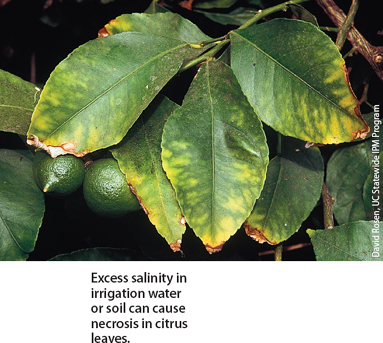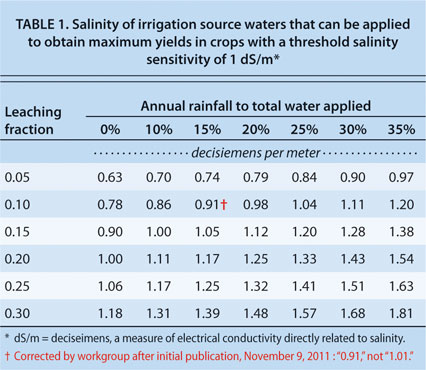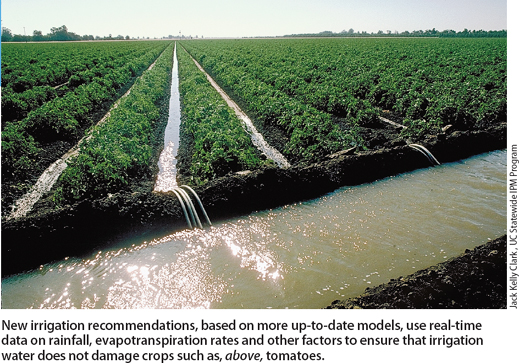All Issues
Water workgroup recommends new salinity guidelines for regulatory agencies
Publication Information
California Agriculture 65(4):182-183.
Published October 01, 2011
PDF | Citation | Permissions
Full text
Leaching requirement guidelines published in the 1980s to help growers manage salt buildup in crop fields now need retooling, say workgroup members appointed by the UC Center for Water Resources. Workgroup chair John Letey, former director of the center, says the group found that current guidelines overestimate the leaching requirement and the negative effects of salinity.
Rather than issuing new recommendations for growers, however, the workgroup has proposed new guidelines for agencies that regulate the water quality of irrigation sources (table 1). They have shared them with California Agriculture, but plan no other formal report.
Salinity is a sensitive issue for agriculture. If salts in irrigation water (such as chloride, sulfate, bicarbonate, sodium, calcium and magnesium) build up in the root zone, plant growth and yields can be affected. In the worst cases, soils become too saline for agricultural use. Leaching is application of extra water to carry salts below the root zone. The leaching requirement (LR) guidelines specify how much extra water (the leaching fraction, LF) should be applied to maintain maximum crop yields.
Significance of LR guidelines
Today, the LR guidelines are more significant than when they were published: If less water needs to be applied for leaching, as the workgroup suggests, groundwater might be more easily protected from pesticides and nitrates carried in drainage water. And if water with elevated salinity levels can be used for irrigation, more water might be available to growers and for competing urban and environmental uses.
Although now perhaps outdated, the LR guidelines were originally a formidable research undertaking.
“They have been published in textbooks and taught in class and are generally accepted as being valid and useful,” Letey says. “I am not critical of them because they were the best that could be done at the time, and they have been useful. However, we can do better presently.”
The original guidelines were calculated from steady-state analysis. In an Agricultural Water Management article (February 2011), the workgroup explained the problem: “Mathematically, a steady-state flow analysis does not include a time variable … Steady-state specifies that applied irrigation water is continuously flowing downwards at a constant rate, irrespective of irrigation frequency … that evapotranspiration is constant over the growing season. Consequently, steady-state solutions assume that the salt concentration of the soil solution at any point in the soil profile is constant at all times. None of these is real.”
There are several transient-state models available that can be used to assess salinity management. Using a transient-state model, a user enters real-time data, including the time and amount of each irrigation, the salinity of the irrigation water, the current evapotranspiration rate for the crop, and so on. The model then creates simulations of dynamic interactions in the root zone and continuously updates the conditions, such as soil-water and salinity, that can affect crop yield.
Recommendation to regulators
The workgroup has no plans to issue new LR guidelines for growers; however, it is recommending new guidelines for regulatory agencies, such as the California State Water Resources Control Board, that manage the quality standards for bodies of water that supply irrigation to growers, such as the San Joaquin River. The new guidelines are based on steady-state analysis but with two important modifications: They use a water-uptake-weighted average of salinity in the root zone instead of a linear average, and they take rainfall into account (table 1).
TABLE 1. Salinity of irrigation source waters that can be applied to obtain maximum yields in crops with a threshold salinity sensitivity of 1 dS/m∗
First, a leaching fraction is chosen, based on the extra water that must be applied to avoid yield loss in the most sensitive crop grown by area farmers; then rainfall is calculated for the area. Using these two figures, the maximum salinity level of the irrigation source can be read off the table. The new guidelines mean that regulators may accept higher salinity readings at any particular point in a river, allowing somewhat more saline discharge waters from growers or other users (such as cities) upstream.
If adopted, the workgroup's recommendations will potentially result in more saline water used in agriculture. Any changes in salinity recommendations are likely to be met with concerns about future water supplies, long-term damage to soils and other issues.
New irrigation recommendations, based on more up-to-date models, use real-time data on rainfall, evapotranspiration rates and other factors to ensure that irrigation water does not damage crops such as, above, tomatoes.
Letey is expecting some resistance to the workgroup's recommendations.
“Oh, absolutely, I expect it,” he says. “People will say ‘You have to convince me’, and that's as it should be. But if we can get by with less water, that's a good thing.”







